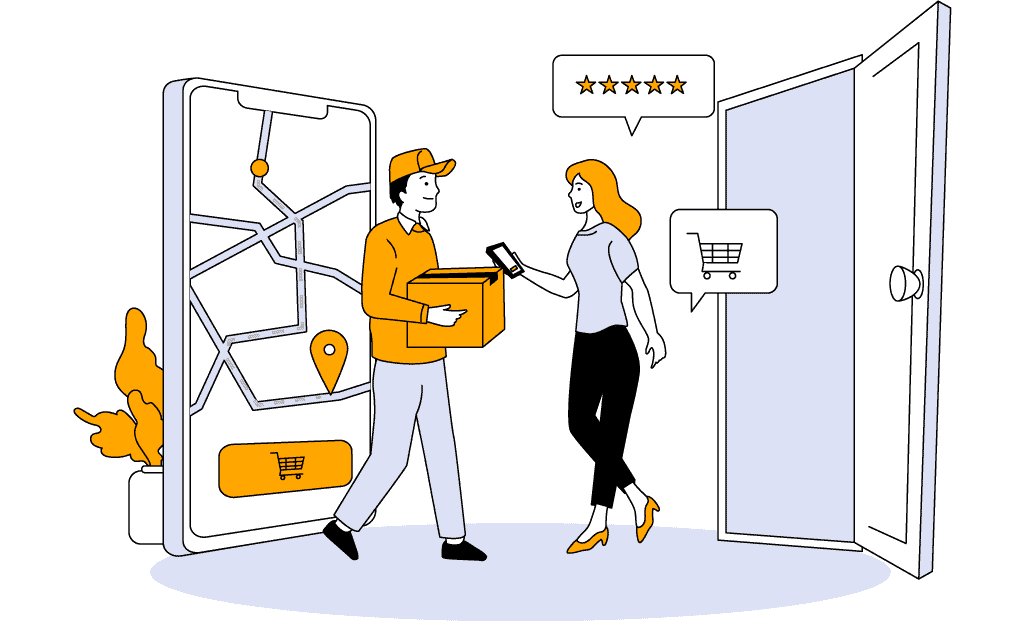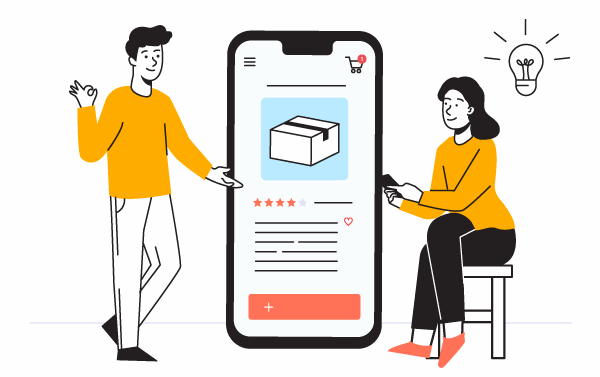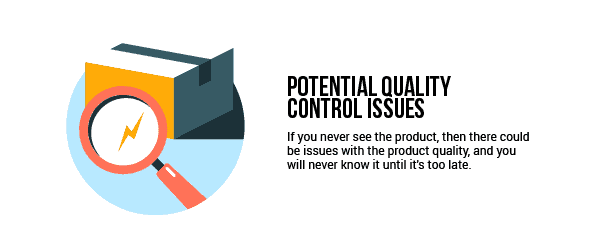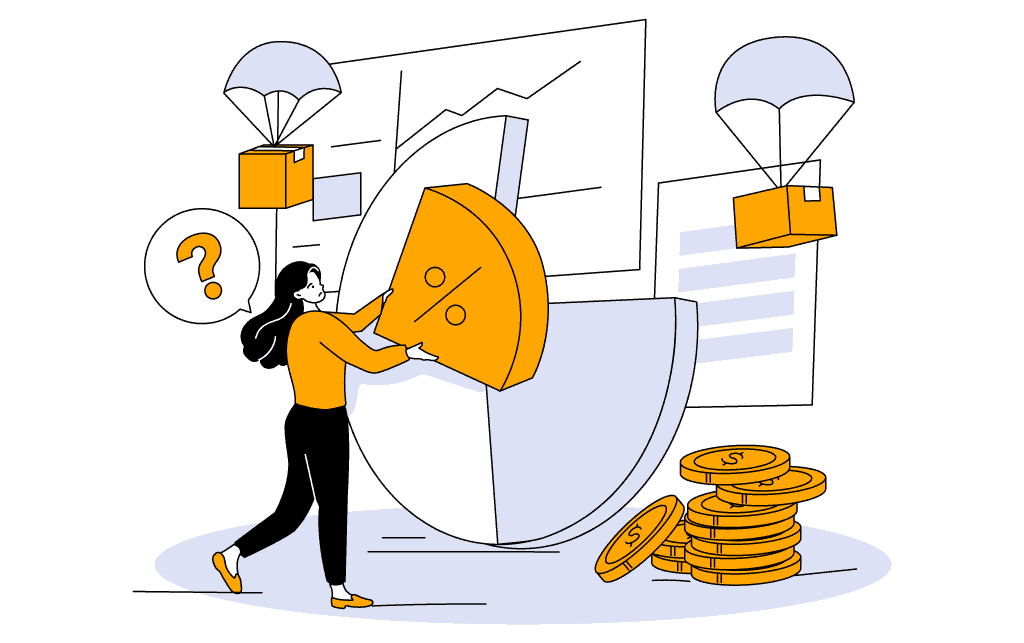Do you want to learn more about dropshipping order fulfillment?
In this guide, we'll show you the process from A to Z and even give you a real-life example of fulfilling a dropshipping order.
Let's dive in!
What is dropshipping fulfillment?
Dropshipping fulfillment is a retail fulfillment method where a business doesn't stock the products it sells.
Instead, they partner with a supplier or manufacturer who handles storage, packaging, and shipping directly to the customer.
It's like being the middleman in an online transaction. When a customer places an order, you simply pass it on to the supplier, who takes care of shipping it to your customer.

This model eliminates the need for warehousing, cuts upfront costs, and reduces the risk of overstocking or unsold inventory.
Dropshipping fulfillment in action: How it works
Here is how a dropshipping order is fulfilled:
- A dropshipping product is listed for sale and gets integrated with a supplier.
- A customer places an order.
- The dropshipping store forwards the order to the supplier.
- The supplier ships the product to the customer.
- The dropshipping store informs the customer about the shipping progress.
Step 1: Integrating with the supply chain
Let's go through an example:
Sam has just launched a dropshipping store called Fashionista.
He starts by selecting products and identifying reliable dropshipping suppliers.
These suppliers provide pricing, order requirements, and product details, allowing Sam to sell without managing inventory.
However, there's some manual work involved, such as creating product listings, managing inventory, and updating prices.
Sam uses tools like Sell The Trend or DSers to help automate these tasks, including finding products and order fulfillment.

Note: Using automation tools for dropshipping is not always necessary. Dropshippers can simply place their orders manually with the dropshipping supplier.
Step 2: Customer places an order
Meet Ms. Niki, who needs a sequin long-sleeve jacket, a flared skirt, and retro sunglasses for Taylor Swift's concert.
She places an order on Fashionista's online store.

Niki completes the payment at checkout and receives an order confirmation via email, which is automatically generated by the store software.
The payment is also automatically deposited into Fashionista’s (Sam's) bank account.
Step 3: Fashionista orders from its supplier
Fashionista forwards the order confirmation email to Wholesale Clothing, their dropshipping supplier.

Wholesale Clothing has Fashionista's credit card on file and uses it to cover product costs, shipping fees, and processing fees.
Step 4: Wholesale Clothing ships the order
If the item is in stock and the transaction goes smoothly, Wholesale Clothing ships the order directly to Niki.

The shipment appears as if it's from Fashionista, with Fashionista's name and address on the return label and their logo on the invoice and packing slip.
Wholesale Clothing then emails an invoice and a tracking number to Fashionista.
Step 5: Fashionista informs the customer
Fashionista notifies Niki about the shipment and sends a tracking number via email.

The fulfillment process is complete once the order is shipped, payment is collected, and the customer is informed.
Fashionista's profit or loss is the difference between what Niki paid and what they paid to Wholesale Clothing.
How do you handle returns as a dropshipper?

Handling returns as a dropshipper is a common challenge you're likely to encounter sooner or later.
Customers might receive orders in the wrong size or variant or simply not meet their expectations.
In that case, what's the best way to handle returns?
Well, returns can get a bit tricky when you're dealing with multiple dropshipping suppliers.
Each supplier comes with its own set of return policies 一 some might not allow returns at all, while others could hit you with hefty restocking fees.
You might even have to foot the bill for postage to send back defective items. It's a mixed bag.
But here's the deal: When a customer wants to make a return, they're coming to you, and you've got to ensure it's a hassle-free process for them.
For that, you need to know how dropshipping returns work:
- The customer asks for a return.
- You request an RMA (return merchandise authorization) number from the supplier.
- You ask the customer to print the RMA form or note the RMA number on the return packaging, depending on the supplier's requirements.
- The customer ships the goods back to your supplier (make sure the customer doesn’t ship the order to your address).
- The supplier refunds your account with the wholesale cost of the items.
- You give the customer a full refund for the merchandise's full price.
Now, there's no one-size-fits-all approach to handling returns as a dropshipper.
Some dropshippers offer 'returnless refunds,' providing customers with a full refund without requiring them to return the goods. This can be particularly useful to avoid the hassle of returns, particularly when suppliers charge restocking fees.
On the other hand, some dropshippers accept returns and follow the whole process. This is more common when dealing with high-ticket products or when you have limited funds, especially during the startup phase.
Both ways are completely acceptable. You just need to figure out a returns policy that aligns with your strategy.
Don't forget to write a clear return policy and put it on your website for all to see. It builds trust with shoppers and provides transparency about your return process.
If you're stuck on how to create one, check out our dropshipping return policy template as a starting point.
Ready to level up? Our ultimate dropshipping guide for 2024 is full of our best insights, ideas, and steps to follow.
Tips for managing dropshipping orders

Here are some valuable tips to help you smoothly manage your dropshipping orders:
- Timely order processing. Don't delay processing your dropshipping orders. Promptly handle each order to ensure it's shipped on time. Delayed orders can lead to customer dissatisfaction and a tarnished reputation.
- Exceptional customer service. Customer service is your secret weapon. Great service builds trust, keeps customers coming back, and turns them into your biggest fans.
- Reliable order tracking. Implement an efficient order-tracking system. Keeping your customers in the loop about where their order is. Plus, it saves you from dealing with a gazillion 'Where's my order?' emails.
- Branded dropshipping. Branded dropshipping is like putting your personal stamp on the products you sell. More work? Yes. But it can mean fatter profit margins and more loyal customers who won't look elsewhere.
- Regular traffic tracking. Pay attention to who's visiting your site. That first order might not be from your ideal customer. Regularly check where your traffic is coming from to tweak your marketing game.
- Beware of frauds. Be on your guard for fishy orders. Sometimes, customers place multiple orders using different payment methods, and it's all a scam. Avoid these to save yourself from a big headache.
- Returns and refunds. Prompt and fair resolutions are your ticket to maintaining trust and keeping customers coming back for more.
Who are the parties involved in dropshipping fulfillment?
Four key parties work together to form the dropshipping supply chain, each with a crucial role in fulfilling customer orders.
P.S. If you're curious about the term 'supply chain,' it's essentially a way of describing the journey a product goes through, starting from its creation, then moving through manufacturing, and ultimately reaching the customer's hands.
1. Manufacturers/brands

Manufacturers are the creators of the products. But they don't usually sell directly to consumers.
Instead, they prefer to deal in bulk, selling large quantities of their products to retailers.
Purchasing from manufacturers often involves buying in bulk, which can be cost-effective.
However, it means you have to handle the stock and either fulfill orders yourself or rope in a third-party fulfillment company to do the heavy lifting.
2. Dropshipping suppliers

Dropshipping suppliers are the middlemen.
They purchase products in bulk from manufacturers and then sell them to retailers, usually at a higher price, to make a profit.
These suppliers often specialize in specific product categories but source their goods from multiple manufacturers.
Like manufacturers, suppliers sell to retailers only and not to regular customers.
Plus, their minimum order requirements are usually more lenient than those of manufacturers.
3. Dropshipping store owners
Dropshipping store owners are the ones who sell products obtained from manufacturers or suppliers to the public.
Their job?
Being the middle person between customers and dropshipping suppliers.
They run marketing campaigns, take care of customer orders, and ensure everything runs smoothly.
4. Customers

Customers are the individuals who browse, click, and make purchases from your online store. They are the end consumers, placing orders and eagerly awaiting their deliveries.
5. Third-party platforms (optional)

Third-party platforms or software solutions simplify order processing and improve communication between the retailer and supplier. Examples include Spocket and DSers.
While you can certainly run a dropshipping store without relying on these platforms, they offer some handy advantages.
For example, they make it easy to discover products and connect with suppliers efficiently, putting a range of supplier options right at your fingertips.
Dropshipping fulfillment benefits
Now that you understand the parties involved with dropshipping fulfillment, you may wonder how it can boost your business.
Here's the deal: With dropshipping, you can diversify your product range effortlessly without the complexities of supply chain management.
Once you team up with a fulfillment partner like Sell The Trend or CJdropshipping, it's as easy as a single click to have products ready for sale in your store at zero additional expense.
Other advantages include:
- No inventory. You purchase products from your supplier only when a customer orders them on your website, eliminating any upfront inventory expenses.
- Low startup costs. All you need is an online store. No need to invest in physical stores or warehouses. Plus, you save on rent by working from home!
- Minimal experience required. Forget about mastering inventory management, logistics, or ecommerce technicalities. You only need to focus on customer service, digital marketing, sales, and conversion optimization.
- Learn useful skills. During your dropshipping journey, you'll develop skills in content marketing and sales. You'll also learn about various product types and how to find winning products to sell.
- Easy to open a dropshipping store. Platforms like Shopify make it a breeze to launch an online dropshipping store. They handle hosting and provide user-friendly tools for managing your store.
- Easy to scale. Unlike traditional retail, dropshipping lets you expand your product offerings without hefty investments in inventory. Plus, you can look into private labeling after finding success with your dropshipping store.
- Diverse product range. You're not limited to specific items. If your supplier adds new products, you can list them in your store at no additional cost.

Dropshipping fulfillment challenges
While dropshipping is an attractive business model with low entry costs, it's not without challenges.
Year by year, the dropshipping community becomes increasingly crowded, and the expenses associated with products and advertising continue to rise, potentially eating into your profits.

Our aim is not to discourage you from trying dropshipping but to prepare you for these challenges.
So stick with us as we guide you through them!
1. Limited control
Being a dropshipper means you don't have full control over order fulfillment. This includes how products are packaged or the delivery timeline for your customers.
How do you deal with this dropshipping fulfillment challenge?
The key is to find reliable suppliers for order fulfillment.
Take the time to evaluate your options and look into supplier reviews on platforms like SaleHoo.
When choosing a reliable supplier, pay attention to:
- Their minimum order requirements
- Quality of customer support
- How fast they reply to your emails
- If they charge fair fees
- Whether they have experience dealing with dropshippers
- How extensive is their product selection
- How fast their shipping times are
2. Unable to combine orders

When a customer orders various products from your online store, and you rely on multiple suppliers for dropshipping fulfillment, combining these items into a single package is not possible.
In addition, you'll have to apply separate shipping fees for each product, given that your suppliers might operate from different locations.
How do you deal with this dropshipping fulfillment challenge?
Unfortunately, there's no ideal fix, but you can take some steps. Add a Frequently Asked Questions (FAQ) section addressing this issue on your website.
And remember, exceptional customer service can make a significant difference. More on that below!
3. Quality control
Since you don't hold inventory, identifying any manufacturing defects in the products is challenging unless a customer reports an issue.

This can result in negative reviews and dissatisfied customers.
How do you deal with this dropshipping fulfillment challenge?
Always order a sample from your dropshipping supplier!
Ordering a sample to your address lets you assess delivery times, packaging, and product quality firsthand.
Also, maintain a good rapport with your suppliers so they are receptive to your feedback and willing to improve product quality when necessary.
4. Stock shortages
Stock shortages can be a significant challenge in dropshipping since you have limited control over your supplier's inventory.
There may come a time when your product suddenly becomes very popular, and your dropshipping supplier struggles to keep up.
How do you deal with this dropshipping fulfillment challenge?
The key is to maintain open and regular communication with your dropshipping supplier. Inquire about their current stock levels and how fast they can replenish inventory.
Should your supplier run out of stock, it's wise to have alternative dropshipping suppliers who offer the same products at the ready.
Basically, maintaining excellent relationships with multiplier suppliers can be your saving grace in such situations.
5. Less profit
One challenge in dropshipping is earning lower profit margins because you typically sell small units. This limits your bargaining power for substantial discounts from suppliers.
How do you deal with this dropshipping fulfillment challenge?
If you’re just starting out, there aren't many options except concentrating on improving your brand and boosting sales.
Once your sales volume grows, explore tiered pricing with your supplier. Many suppliers are open to this when you consistently generate substantial business for them.

6. Complicated returns
Managing returns in dropshipping can be complex. This is especially true when your supplier is based in another country, resulting in shipping times of two to three weeks.
Plus, coordinating returns and exchanges can become quite challenging when you're dealing with multiple suppliers and shipping companies.
How do you deal with this dropshipping fulfillment challenge?
The most practical approach for managing refunds and returns in dropshipping is to assess if it's more cost-effective to let customers keep the product and send a replacement.
Alternatively, you can initiate a return to your suppliers.
If you'd like to explore this further, feel free to read our comprehensive guide on dropshipping returns and refunds.
7. Customer service issues
Resolving product quality issues requires communicating with the supplier before providing a solution to the customer.
This can potentially cause delays and negative reviews.
How do you deal with this dropshipping fulfillment challenge?
As always, respond to customer inquiries or demands with politeness and understanding.
You can also create a FAQ page where customers can get the answers to the most commonly asked questions.
For more in-depth information, explore our article on customer service for dropshipping stores.
8. Poor unboxing experience
Since customers can't physically touch products before buying, the unboxing experience becomes a valuable opportunity to make a memorable impression and distinguish yourself from competitors.
However, creating a premium unboxing experience can be an ongoing challenge for dropshippers.
How do you deal with this dropshipping fulfillment challenge?
Start by negotiating with your dropshipper to include thank-you notes with every order, adding a personal touch.
While these gestures may seem ordinary, our experience has shown that customers genuinely appreciate them, often resulting in positive feedback.
Additionally, ask your supplier about the possibility of custom packaging for your orders, even if it comes with extra costs. Keep in mind that this option is typically feasible when you have multiple orders from the same supplier.
Summary
Before we conclude, let's quickly recap the key points from this article for easy reference:
- Dropshipping fulfillment is when businesses don't stock products but partner with suppliers who handle storage, packaging, and shipping directly to customers.
- Manufacturers, wholesale distributors, retailers (including you), and customers are crucial parts of the dropshipping supply chain.
- The benefits of dropship fulfillment include no inventory, low startup costs, minimal expertise needed, skill development, easy store setup, scalability, and a diverse product range.
- Challenges include limited control, inability to combine orders, quality control, stock shortages, reduced profit margins, complicated returns, customer service issues, and poor unboxing experience.
- Craft a clear returns policy and display it on your website for transparency and trust-building.
Final thoughts
Dropshipping fulfillment is like having a helping hand in your online business.
It allows you to focus on what you do best – building your brand and marketing – while third-party fulfillment services handle the logistics behind the scenes.
While it does have its challenges, like dealing with suppliers and returns, the perks of saving money and business growth make it a great choice.
So are you ready to dropship in 2024?
Want to learn more about dropshipping?
Ready to move your dropshipping store to the next level? Check out the articles below:
- Dropshipping Mindset: 6 Things to Know Before You Start
- Marketing for Dropshipping: How to Pick the Right Method
- 12 Ways Dropshipping Stores Lose Money (Increase Your Profits)
Plus, don’t forget to check out our in-depth guide on how to start dropshipping here!










